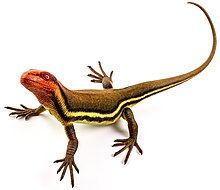Hylonomus
| Hylonomus | |
|---|---|

| |
| Model | |
| Scientific classification | |
| Domain: | Eukaryota |
| Kingdom: | Animalia |
| Phylum: | Chordata |
| Class: | Reptilia |
| Clade: | Eureptilia |
| Genus: | †Hylonomus Dawson, 1860 |
| Type species | |
| †Hylonomus lyelli Dawson, 1860
| |
Hylonomus (
Description


Hylonomus was 20–25 centimetres (8–10 in) long (including the tail). Most of them are 20 cm long and probably would have looked rather similar to modern lizards. It had small sharp teeth and it likely ate small invertebrates such as millipedes or early insects.[3] They are also described to have slender and lightweight leg and arm bones, as well as long and slim hands and feet. A narrow and tongue-shaped part in the roof of the mouth, a deep groove on a certain bone in the skull, a bumpy structure on the back bones, changes in the height of certain back bone parts, having a hole in a specific place on the skull, having arm and leg bones that are the same length, having a short fourth toe bone compared to the shin bone, having a short fifth toe bone compared to the fourth toe bone, having long neck bones, and having a well-developed opening below the eye. [4]
Fossils of Hylonomus have been found in the remains of fossilized
Fossils of the basal pelycosaur Archaeothyris and the basal diapsid Petrolacosaurus are also found in the same region of Nova Scotia, although from a higher stratum, dated approximately 6 million years later.[2]
Fossilized footprints found in New Brunswick have been attributed to Hylonomus, at an estimated age of 315 million years.[6]

This animal was discovered by
Hylonomus lyelli was named the Provincial Fossil of Nova Scotia in 2002.[10]
References
- ^ Genus Hylonomus Etymology
- ^ S2CID 25065918. Archived from the original(PDF) on June 28, 2011. Retrieved 2009-09-02.
- ISBN 978-1-84028-152-1.
- ^ Muller, J.; Reisz, R.R. (2006). "The phylogeny of early eureptiles: Comparing parsimony and Bayesian approaches in the investigation of a basal fossil clade". Systematic Biology. 55 (3): 503–511. doi:10.1080/10635150600755396. PMID 16861212.
- ISBN 978-0-231-16057-5. Retrieved 10 June 2015.
- ^ Falcon-Lang, H.J., Benton, M.J. & Stimson, M. (2007): Ecology of early reptiles inferred from Lower Pennsylvanian trackways. Journal of the Geological Society, London, 164; no. 6; pp 1113-1118. article
- ^ J. W. Dawson. 1860. On a Terrestrial Mollusk, a Chilognathous Myriapod, and some New Species of Reptiles, from the Coal-Formation of Nova Scotia. Quarterly Journal of the Geological Society of London 16:268-277
- PMID 16861212.
- S2CID 209673326.
- ^ "Provincial Fossil Act". Office of the Legislative Counsel, Nova Scotia House of Assembly. Retrieved 9 November 2018.
External links
- Fossils of Nova Scotia - The Tree Stump Animals
- Transitional Vertebrate Fossils FAQ Part 1B
- Early Researchers & Finds of the Joggins Fossil Cliffs
- The Science of the Joggins Fossil Cliffs
- Hylonomus: Provincial Fossil of Nova Scotia Archived 2017-12-10 at the Wayback Machine
- A photograph of the disarticulated skeleton, credited to J. Calder
- Another photo of the specimen, from Dr. Melissa Grey's twitter account
